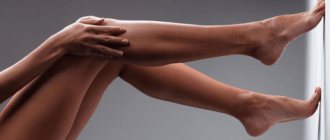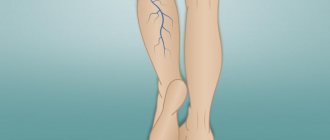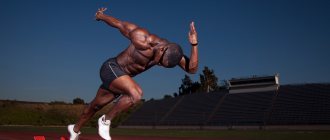Win the war against slouching
- Kitty. This is a modified exercise specifically for those who sit. The point is to stretch the lower back muscles and wake up the abs, which actually helps support the lower back. Sit upright, straighten your back and open your chest, directing it forward and upward. Now twist your back in the opposite direction - point your shoulders forward and down, tense your abs, pushing your lower back back. Additionally, point your chin towards your chest and pull your forehead towards your stomach. Repeat several times.
- Downward sloping lock. Perform the “back lock” exercise, and then tilt your body forward, placing your stomach on your thighs. At the same time, move your hands up and forward in the lock.
- Pulling. To stretch our back and relax our vertebrae, we reflexively stretch upward. Use this as an exercise - point your arms up, either free or clasped, and stretch with them as high as possible while remaining seated in the chair.
Stop hunching!
Smooth posture in 2 minutes - video. The main problem with slouching and poor posture is that it all comes unnoticed. At first you slouch at your desk, and a year later you notice that you are rounding your spine at home at the dinner table.
How does this happen?
The main cause of slouching in adults and children is poor posture. As a rule, the main reason for this is too much time on the computer. Many of us can sit like this all day without interruption. Hence the muscle imbalance.
When we slouch, our shoulders, and behind them our neck, move forward, disrupting our posture. This position contracts the pectoral muscles and weakens the back muscles (upper part), creating all the conditions for the appearance of a hump.
Getting rid of such imbalances has a number of advantages. Studies have shown that, in addition to the obvious impact on appearance, correct posture affects our mood, self-confidence and even helps overcome feelings of fear.
But is it possible to correct your posture if you are no longer at the age when your body is actively growing and is easily amenable to corrective measures? Yes. By regularly performing exercises against stooping, you can eliminate the problem, no matter how old you are. Next, we have selected for you a fairly simple workout that can be performed both at home and in the office.
As mentioned earlier, slouching can be a result of weak upper back muscles, core muscles, pectoral muscles, hamstrings, and hip flexors.
Back exercises are another way to get rid of slouching as an adult.
Perform these exercises several times a week, in addition to stretching exercises.
This type of push-up is aimed at working the muscles of the upper back, which are responsible for the correct position of the shoulders.
Start in a standard push-up position. Make sure your shoulders are relaxed and your body is in a straight line from head to heels.
Now bring your shoulder blades together and return to the starting position. The range of motion in this exercise, compared to classic push-ups, is quite small. However, this is a fairly effective exercise for a hunched back.
Perform 5-10 repetitions.
Wall-supported scapula raises target the muscles of the upper back and also help return the shoulders to their normal position.
Press your back against the wall. Press your tailbone, lower back, upper back and head against the wall, and move your legs slightly forward. Keep your chin straight, bend your elbows at an angle of 90 degrees and press them against the wall, as shown in the picture above.
Stay in this position for 30-60 seconds. To increase the involvement of the upper back muscles, you can move your arms slightly up and down.
Many people find this exercise difficult at first. Therefore, if you are a beginner, choose elastic bands with minimal resistance.
Wrap the elastic band around a stable object (such as a column or post) at waist level. Bend your elbows at a right angle, pull the band towards you, while bringing your shoulder blades together.
Return to the starting position. Perform 8-12 repetitions.
Now you know how not to slouch and what to do if your posture does start to deteriorate. But remember, stooping does not appear in one day and it also cannot be corrected in one day.
Be patient, do stooping exercises regularly and take breaks if possible, do not sit at the computer all day.
Gomukhasana: how to put your hands behind your back
For many students, the task of clasping their hands behind their back in Gomukhasana seems impossible. Often the situation does not improve, even if we constantly work on opening the shoulder girdle. Why? The answer is simple: it’s not only and not so much about the shoulder muscles. In this asana, we bring our shoulders to a completely unusual position for them: we completely bend the shoulder (this is the name in anatomy for the movement that we make when we raise our arm up) of the “upper” arm and rotate it from the inside out; the shoulder of the “lower” arm rotates inward and extends (the action we perform by moving the arm back).
The Great Controversy
Moving the shoulder in one direction may be difficult due to stiffness in the muscles that move it in the opposite direction. Thus, the flexion of the shoulder and its outward rotation can be limited by the rigidity of those muscles with which we extend and rotate it inward: this is the latissimus dorsi muscle (it starts from the lower back and middle part of the back and stretches up to the armpit, connecting to the humerus) and the large pectoral muscle (starts from the collarbone and sternum and also connects to the shoulder bone). To stretch these muscles, regularly perform backbends on a support: lie on your back with a rolled-up blanket or brick under its upper part. For a few minutes, stretch your arms behind your head and relax. Make sure your shoulders are rotating outward and your palms are facing each other.
Power grab
The triceps (the muscle located at the back of the shoulder) can also limit the movement of the “upper” arm in Gomukhasana. With the help of the triceps we extend the shoulder and elbow. A stiff muscle makes it much more difficult to flex the shoulder and elbow at the same time.
Try working your top arm in Gomukhasana when the pectoralis major, latissimus dorsi and triceps are well warmed up (for example, after Sun Salutation). Get into Tadasana. Turn your right arm outward and bend your shoulder 90 degrees. Grasp the back of your right shoulder with your left hand to help maintain external rotation of the shoulder. Then raise your right arm above your head and bend it at the elbow. Keeping your triceps pointing straight forward, touch your right palm to your upper back. The left forearm should be opposite the forehead. Lengthen from the back of your waist to your shoulder (latissimus dorsi) and from your shoulder to your elbow (triceps), and lengthen your left side. Stay in this position for 1-2 minutes. Keep your right hand close to your ear, without letting it swing to the side or back. Don't arch your lower back.
If the muscles are too stiff, you can use a support. Stand in a doorway, extend your right arm up, bend it at the elbow and press your right triceps into the doorframe. Gradually move your armpit closer to the support, while your elbow should move up towards the ceiling. Remember that the lower back should not bend. In this position, the right shoulder and right triceps are very well stretched.
Hand in hand
Now let's move on to the “bottom” hand. Proper shoulder movement in this position is limited by the external rotator and elbow flexor muscles. The main muscle that is responsible for flexing the shoulder is the deltoid (a triangle-shaped muscle that “covers” the shoulder from above). It is assisted by the clavicular part of the pectoralis major muscle, as well as the biceps and coracobrachialis muscles (both belong to the anterior group of shoulder muscles). External rotation, in turn, is carried out mainly due to the work of the teres minor and infraspinatus muscles, which start from the scapula and, crossing the shoulder joint, are attached to the outer part of the humerus.
To stretch and lengthen these muscles, do the following exercise twice a day for one minute.
Stand up straight, place your hands behind your back and place one forearm over the other so that your palms point towards your elbows. Open and lift your chest. Direct your inhalation into your upper chest and the front of your shoulders. When this position becomes comfortable, begin to move one hand up your back, gradually bringing your palm to the area between the shoulder blades. Remember to lift your sternum and keep your shoulders back and down. Once you manage to position your hand between your shoulder blades, try Gomukhasana. Photo: groundbloomflourish.com
Neck and shoulders
Perhaps the very first and most common area that suffers from sedentary work. Even at school, we can “climb into the shell,” thereby disrupting blood flow to the brain. The following exercises can be used both for prevention and to correct existing congestion - they are aimed at stretching the muscles. It is important to do them smoothly, not to try to turn as far as possible, but to gradually increase the range of movements.
- Turns the head left and right. This is a simple exercise from any warm-up or exercise. Sit straight, make sure your knees are over your heels, relax and lower your shoulders down. Alternately turn your head without tension, for example, counting to 10.
- Stretching the shoulders and back. To restore mobility to your shoulder joints and stretch your muscles, raise and lower your shoulders up and down. It is important not to twist your back and completely relax your shoulders when you lower them down. You can complement this exercise with circular movements back and forth. Raise your shoulders up, point them forward, lower them down, bring them back and lift them again. Do 10 circles forward and backward.
- The castle is behind you. This universal exercise not only helps the shoulders and neck, but also stretches all the muscles of the arm, opens the chest and stretches the fingers. Which is especially important for those who type or perform small manipulations with their hands. Sit upright, bring your shoulder blades as close to each other as possible, straighten your arms behind your back and clasp your fingers. Now pull the lock away from you as far as possible. You can complicate the exercise by turning the lock outward - open your thumbs and point them down, turning your palms towards the floor.
Exercises for the wrist and hand
- Stand with your feet together, hands on your waist, hands clenched into fists. Unclench your left hand, place your arm behind your back, bending it at the elbow. The palm should be turned inward and the fingers should touch the shoulder blade. Raise your right hand up and slightly to the left. Bend your palm, raise your head and focus your gaze on your hands. Rotate your body to the left so that your lower body remains motionless. Return to the starting position. Repeat the exercise 30–60 times.
- Stand with your toes apart and lower your arms. Make a fist with your right hand so that your thumb is covered by the rest. Bend your elbow 90° and begin to move your wrist away from you. Repeat the exercise 20 times for each hand.
- Stand with your feet together and your arms down. Place your left hand behind your back, bending it at the elbow. In this case, the palm should be facing outward. Move the brush up your back. Bend your right arm at the elbow, with your palm facing forward, raise your arm above your head. Turn your hand palm up, extending your arm and standing on your toes. Straighten your fingers while simultaneously bending and extending your wrist. Place your heels on the floor and return to the starting position. Repeat the exercise 20 times.
- Stand with your legs slightly apart and lower your arms. Bend your right arm at the elbow 90° and straighten your fingers. Perform shaking movements. Bend your fingers slightly and move your hand into radial flexion. Raise your forearm and bend your hand towards your elbow. Repeat this exercise for your left hand.
- Stand with your toes spread out to the sides, clench your hands into fists and press the backs of your hands together. The forearms should be at shoulder level, and the fingers should “look” down. Rotate your fists so that your thumbs touch. Bring your fists together and extend your wrists. Repeat the exercise 10 times.
- Stand with your legs together, palms pressed together in front of your chest (as during prayer). Press on your palms and relax. Repeat the exercise 10–20 times.
- Stand with your toes pointed to the sides. Raise your shoulders, bend your elbows and straighten your hands, pressing your fingers together. Apply pressure to your fingers, using your shoulders and forearms. Stay in this position for 30 seconds and relax.
To restore muscles after strength training, not only stretching is important, but also a balanced diet. Herbalife 24 recovery cocktail is a source of protein and helps build muscle mass. Also contains iron, which helps oxygenate tissues.
Stretching
Stretching exercises are the main exercises for correcting stooped posture in any person. Stretching helps release tension in the chest, hip flexors, hamstrings, and quadriceps, allowing the spine to become more upright without having to pull the body forward by hunching the back.
Try to perform each exercise for 20-30 seconds several times a day. If the situation is not as dire as it seems, then just a couple of exercises will be enough to avoid slouching.
This is one of the simplest exercises that allows you to open your pectoral muscles and stretch your shoulders. Concentrate on pulling your shoulders back and down, while keeping your neck straight, without moving it forward.
Stand straight, arms relaxed at the sides of the body. Clasp your hands behind your back. Gently move your shoulders back until you feel maximum chest opening and tension in the front of your shoulders.
Just like spasms in your chest and shoulder muscles, spasms in your hip extensors can cause your torso to move further forward. Relaxing this muscle group will help maintain your posture and counteract the tension of sitting for long periods of time.
Start in a classic lunge position: back straight, right leg bent at the knee in front, left leg extended back. Slowly lower your left knee toward the ground until you feel tension in the back of your thigh. To make the exercise more effective, tighten your calves on your left leg. Hold this position for 20-30 seconds, then do the same with your right leg.
It would seem that we are talking about stoop. How to correct slouching by paying attention to the lower body? Everything is very simple. Our body is a single organism. Since the quadriceps are located at the front of the body, poor posture causes these muscles, just like the chest muscles, to become compressed. If you spend most of your time at the computer, then doing quadriceps stretching exercises is doubly important for you.
Stand straight, bend one leg at the knee and clasp your foot with your hand. Gently pull your foot toward your buttocks until you feel a slight stretch in the front of your thigh.
Sitting at a computer for a long time can lead to stagnation in the hamstring muscles. This congestion can lead to slouching as these muscles are connected to the pelvic spine.
To perform the exercise, sit on the floor, stretch your right leg in front of you, bend your left at the knee and rest your foot on the knee of your right leg. Lean forward until your chest touches your hips, reaching with your hands towards your right foot.
Hold this position for 20-30 seconds, then repeat on the other leg.
How to correct your posture? Habits that are bad for your back
People with good posture immediately make a good impression and exude self-confidence. But how often do you meet someone like that: with shoulders back and a straight back? Unfortunately, the modern lifestyle makes us cramped, because we sit at work, in the car and public transport, and spend long hours at the computer. And if you don’t pay attention to your posture and don’t exercise, you can soon easily turn into the visual embodiment of a question mark.
How can you tell if you have uneven posture?
Not every person can realize that he has problems with the spine. Of course, if obvious omissions are not noticeable to the naked eye from the outside. For other cases, there is a simple test, which was described on his Instagram by osteopathic doctor Andrei Shmykov
.
Andrey:
So, find any flat wall. Now lean your back, buttocks and heels against it. Remember to place your feet straight and keep your head so that your gaze is directed forward. Stand in this position for some time, at least 1-2 minutes. If at the end you realize that this body position is uncomfortable for you, then congratulations - you need to work on your posture.
“Magic has happened!” What happens to your spine if you sleep on the floor for a month?
But doctors do not approve of such extreme behavior.
Most likely, after a light check, many people will have to work on their posture. This is because harm to the back can be caused not only by serious external factors and injuries, but also by improperly selected shoes and routine habits repeated day after day. We talk about three of them and share ways to solve the problem.
A protruding head is the fault of the phone and computer
Our life is inextricably linked with various gadgets. Many people have sedentary work at the computer, during which we involuntarily pull our heads closer to the screen. Most people do not part with their smartphones even for a minute, hanging out on social networks, instant messengers and scrolling through news feeds. To do this, we again stretch our heads forward or tilt them down. All these actions not only create unnecessary tension for the muscles of the neck and spine, but also gradually lead to the fact that they remember this position and become too rigid, and the head begins to constantly stretch forward. This leads to lower back pain, and the stomach begins to protrude unsightly.
Photo: istockphoto.com
How to fix?
Retrain your muscles by stretching. This is quite simple to do, the main thing is to practice regularly. Smoothly move your head back and stay in this position for 30 seconds. You should feel tension in your chin and throat. Then tilt your head back and to the right for 30 seconds, and then back and to the left for another 30 seconds.
In addition, you can install a mirror at your desk and control yourself so that your head does not protrude forward.
What will happen to your body if you do a shoulder bridge every day?
Will this exercise help you on your way to a great figure or harm you? The coach answers.
Slouching is a consequence of a sedentary lifestyle
Along with a forward-stretched head, many suffer from stooped posture. Agree, it looks ugly. The chest muscles contract and “shrink”, the shoulders rise up, the back hunches. The most common reason is a sedentary and sedentary lifestyle. In your younger years, you may not pay attention to this, but with age you will definitely develop unnecessary problems with your spine. Slouching occurs due to excessive tension in the pectoral muscles and weakness of the erector spinal muscles.
How to fix?
Stretch your chest. For example, using a regular hang or half hang on the horizontal bar. Even an unprepared person can cope with this, and for this it is not necessary to sign up for a gym. There are horizontal bars at many sports grounds, or you can buy a homemade bar - they are installed in a doorway or on a wall. Hanging allows you to stretch your shoulders and chest using your own weight.
What will happen to your back if you hang on the horizontal bar every day?
Together with the coach, we figure out whether this exercise is really as useful as they say.
There are a lot of ways to stretch the pectoral muscles and spine, and some of them don’t even require equipment. We'll give you a couple of exercises that you can easily do at home without additional equipment.
Stretch in the doorway
Stand in the doorway, with your side to the frame. Bend your elbow at a right angle and place your palm and forearm on the frame. Rest against it and slowly turn your body in the direction opposite to your arm, stretching the muscles. At the same time, you must keep your back straight. It is enough to stretch for a minute on each side.
Stretch against the wall
To train the erector spinae muscles, you need to stand against a wall. It should touch the heels, back, buttocks and back of the head. The hands are lowered down at this time. Slowly lift them along the wall, as if you were about to make a snow angel, and stop when they are parallel to the floor. Then bend your elbows and slowly extend them above your head. The elbows and backs of the hands should be against the wall, and it is important to maintain a straight posture. Do two sets of 20 repetitions.
Photo: istockphoto.com
Japanese Fukutsuji method: a simple exercise with a towel that helps you lose weight
A thin waist will be a bonus for beautiful posture.
Anterior pelvic tilt due to lack of mobility
The pelvis should be in the correct position - vertical, then it will be easier for the spine. But you can encounter a problem when the pelvis is tilted forward, and often a sedentary lifestyle is to blame for this. In a sitting position, the hip flexor muscles are always tense, and the buttocks, on the contrary, are weakened. The anterior thigh muscles adapt to this position and become rigid, pulling the pelvis towards them and preventing them from taking the correct position.
How to fix?
If possible, spend as little time sitting as possible. When working at a computer, for example, it is useful to get up and walk a little every hour. There are also special exercises for stretching the shortened hip flexors. Get into a lunge position: place one knee on the floor and rest your other foot on your foot. Slowly lean back, stretching the front of your thigh. After a minute, switch legs.
Another exercise should be performed as follows: place your knees and palms on the floor, your arms should be straight, your torso should be parallel to the floor. Raise your right arm and left leg at the same time, maintaining the correct curves of the spine. In this way, only the muscles of the buttocks and shoulder blades are used.
Photo: istockphoto.com
There should be no suffering in amateur sports. How to exercise without pain
Osteopath Kirill Mazalsky talks about how to maintain health, avoid injuries and where to start training.
The main thing is an integrated approach
You can get rid of most bad habits on your own with the help of attentiveness, training and choosing the right shoes. However, the osteopathic doctor is confident that it is better not to neglect real problems with posture and solve them comprehensively under the supervision of a specialist.
Andrey:
As an osteopath, I believe that proper footwear - heel and fit - for both men and women plays an important role in preventing and maintaining correct posture. If you have problems with training to restore correct posture, then there is a third way - medical. An osteopathic doctor determines what caused the incorrect posture (believe me, it’s not always just sitting at a table), finds the presence of organ displacement and possible malfunctions or pinching. And after such a diagnosis, work begins on relaxing the muscles, because after this the spine is able to straighten and, accordingly, ensure the normal functioning of the organs pinched due to posture. And in the future, preventive maintenance of the obtained effect will be required.
Legs
During sedentary work, all leg muscles suffer - from the buttocks and back of the thigh, on which we sit, to the feet, depending on how we position them. It is more effective to stretch the leg muscles while standing using your own weight, but you can also do this at a table.
- Sit with a straight back, leave one leg on the floor, and extend the other forward. Try to raise it as high as possible, straining the front surface of the thigh. Pull your heel away from you and point your toes toward you, stretching the Achilles tendon. Repeat with the second leg.
- Open your pelvic muscles. Bend one leg at the knee and place its heel on the other thigh, swinging the bent leg. Repeat with the second leg.
- Stretch your hamstrings and glutes. Bend your leg, lift it as high as possible, and clasp it with your arms. Pull your knee towards you. Repeat with the second leg.
How to fix slouching
Stretching
If you decide to fight stoop, then first of all you should pay attention to stretching. Regularly performing the exercises suggested below will help you maintain the correct vertical position of your back and not round your shoulders. Hold the position for 20 to 30 seconds several times a day.
Chest and shoulder muscles
Starting position: standing. Clasp your hands behind your back. Focus on gently pulling your shoulders back and down, avoiding pulling your neck forward.
Anterior thigh muscles
Starting position: standing, right leg in a lunge. Lower your left knee and push your hips forward slightly until you feel a stretch deep in your hamstrings. Switch legs.
Quadriceps femoris
Starting position: standing. Grab your leg with your hand behind you and gently pull up until you feel a slight stretch in the front of your thigh. Switch legs.
Hamstrings
Starting position: sitting. Stretch one leg forward, bend the other in front of you so that the knee is pointing to the side and the heel is towards the groin. Slowly lower your chest down to your thigh, using your hands to reach the toe of your straight leg. Switch legs.
Back exercises
The proposed exercises will help strengthen the muscles in the area of the shoulder blades, which are responsible for moving the shoulders back and down. Perform these several times a week in addition to stretching.
Scapular push-up
Get into a push-up position. The body should form one straight line from head to toe. Squeeze your shoulder blades together and then return to the starting position. Perform 5-10 repetitions.
This type of push-up, unlike a regular push-up, involves making a small movement and is aimed directly at the upper back muscles, which are responsible for bringing the shoulders into the correct position.
Sliding along the wall
Starting position: standing with your back to the wall. Tuck your chin in and press your hands against the wall, keeping your elbows at a 90-degree angle. Hold the position for 30–60 seconds. To better work the upper back muscles, you can slowly move your arms up and down.
Scapular abduction
Stretch the band around a stable object at waist level. Keeping your elbows at your sides at a 90-degree angle, pull the band toward you until you squeeze your shoulder blades together. Return to the starting position and perform 8–12 repetitions.
Yoga
Yoga helps develop strength and flexibility, which is great for correcting posture. The proposed poses will help stretch and strengthen problem areas. Stay in each position for 20-30 seconds.
Cobra
Starting position: lying on your stomach. Push off the floor and straighten your elbows, trying to engage your back muscles. Focus on opening your shoulders while tilting your head back slightly.
Downward facing dog
Starting position - standing on all fours, hands under your shoulders. Push off the floor and straighten your legs, lifting your hips toward the ceiling. Strive to keep your head and neck in line with your spine, and try to touch your heels to the floor.
Upward facing dog
Starting position: lying on your stomach. Push your hands off the floor and straighten them completely, placing your feet on your toes. Your hips should rise slightly off the floor so that you feel a stretch in your chest and shoulders. You can combine the two poses by moving from Downward-Facing Dog to Upward-Facing Dog in one fluid motion.
Basic exercises
Strengthening the core muscles with the suggested exercises will help set the spine in the correct position.
Plank
To perform a plank, assume a push-up position with your hands under your shoulders and your body in one straight line. You can also do exercises on your elbows. Hold the position for 30–60 seconds.
Medicine ball exercise
Starting position - lying on the floor, legs and arms extended upward. Hold a medicine ball (1 or 2 kilograms) or other suitable weight. Lower your right leg and left arm off the floor, holding the ball overhead between your left leg and right arm. Switch legs and arms. Perform 8–10 reps.
Exercises with a massage roller
This is a very useful tool for myofascial release, which will help relieve tension in the muscles and connective tissues.
The foam roller helps increase blood flow to muscle tissue, improves mobility, speeds recovery and improves performance. Try using it 2-3 times a week for maximum results.
Upper back
Lie on your back and place the bolster under your upper back. Cross your arms over your chest or clasp them behind your head and slowly roll back and forth. Pause in areas of tension for 20–30 seconds.
Rib cage
Turn over to face the floor and place the bolster under your rib cage near your shoulder joint. Move your hand up and down, feeling the roller hit various points of tension in your chest. Stay at these points for 20–30 seconds. Repeat on the other side.
Now you know five simple ways to win the war with rounded shoulders. Remember that the result will depend on the regularity of performing the proposed exercises and poses.
Yoga
At 30 years old, not all exercises for stooping are easy. For example, yoga poses require a unique combination of strength and flexibility. If, despite the previously mentioned exercises, you are still wondering “how to correct bad posture at home,” then we have selected several simple but effective yoga poses especially for you.
Cobra pose
Cobra pose not only allows you to open your chest as much as possible, but also works your back muscles. This exercise is great for slouching, helping to straighten your spine and push your shoulders back.
To perform this exercise, lie on your stomach. Tighten your lower back muscles and push away from the floor with your hands.
Focus on pushing your shoulders back as far as possible, tilting your head back slightly. Stay in this pose for 20-30 seconds.
This pose not only opens the chest, but also strengthens the front of the shoulders and lengthens the spine.
Get on your knees, place your hands on the floor so that your palms are directly under your shoulders, and keep your back straight. Gradually straighten your legs while lifting your hips up.
Hold the position for 20-30 seconds.
Upward facing dog
Upward-facing dog pose is similar to cobra pose, except that in this case, the hips are lifted off the ground and the arms are fully extended. This pose helps strengthen the muscles of the chest and abs, as well as the lower back and shoulders.
Lie face down on the floor. Straining your lower back, lift your body off the floor and, leaning on your hands, stretch your head up.
Your hips should lift slightly off the floor.
Stay in this position for 20-30 seconds. This pose can also be combined with upward-facing dog.
Exercises for the elbow joint area
- Stand up, lower your arms and relax them. Clench your right hand into a fist and, bending your elbow, pull your arm towards your body. Bend the brush too. Alternate the exercise for your left and right hands. Only 20 repetitions for each.
- Stand up, spread your legs shoulder-width apart, put your hands on your waist, clench your hands into fists. Slowly bend your arms and raise your fists in front of you to shoulder level. Unclench your fists and close your fingers, then put your palms up. Raise your arms with great effort while squatting down as if you were trying to lift a heavy object. As soon as your hands are above your head, turn your palms down and, mentally leaning on the object, stand in the starting position. You need to repeat the exercise 10 times.
- Stand with your feet shoulder-width apart and lower your arms. Slowly raise your arms, pushing your shoulders forward and bending your elbows. Turn your palms inward, squeezing your fingers slightly. Place them before your eyes. Turn your palms outward. Lower your elbows just below shoulder level. Slowly but forcefully spread your arms to the sides, sticking out your chest (in an arc). Freeze in this position for 30 seconds, then return to the starting position. Repeat the exercise 10 times.
- Stand with your toes apart, place your hands on your waist and clench them into fists. Open your right hand and raise your arm toward your shoulder, palm facing inward. Quickly lower your elbow to the right and down. Alternate the exercise for your left and right hands. A total of 30 repetitions for each.
- Stand with your feet shoulder-width apart and lower your arms. Make a fist with your right hand and bend your elbow to 90°. Press your hand to your body and freeze in this position for a few seconds. Rotate your wrist so that the front of your forearm is facing down. Repeat the previous exercise, as if waving a fan. A total of 30 repetitions for each arm.
- Stand with your feet shoulder-width apart, place your hands on your waist and clench them into fists. Slowly bend your right arm at the elbow to the maximum, and then sharply straighten it, striking downwards. Return to the starting position. Repeat the exercise 30 times for each hand.
- Stand with your feet shoulder-width apart, place your hands on your waist and clench them into fists. The exercise is performed at a dynamic pace. With your elbows bent, raise your arms so that your fists are on either side of your head. Bend back, throwing your arms back and bending your torso. Repeat the exercise 10 times.
Brain workout
Our productivity is affected not only by physical activity, but also by mental stress. When overworked, fatigue inevitably sets in, which weakens brain functions. We begin to make careless mistakes, forget some details, and cannot immediately grasp the essence of the task. To increase your productivity, combine body training with brain training.
Vikium brain simulators are designed in a simple game form, and one workout takes only 10 minutes. The program itself will create a development program for you and will even remind you that it’s time to cheer up. Train for free for a quick boost, or get full access for the ultimate boost. Be productive every day!
How to remove a slouched back at home and why is it necessary?
Stop hunching! Smooth posture in 2 minutes - video.
The main problem with slouching and poor posture is that it all comes unnoticed. At first you slouch at your desk, and a year later you notice that you are rounding your spine at home at the dinner table.
How does this happen?
The main cause of slouching in adults and children is poor posture. As a rule, the main reason for this is too much time on the computer. Many of us can sit like this all day without interruption. Hence the muscle imbalance.
When we slouch, our shoulders, and behind them our neck, move forward, disrupting our posture. This position contracts the pectoral muscles and weakens the back muscles (upper part), creating all the conditions for the appearance of a hump.
Getting rid of such imbalances has a number of advantages. Studies have shown that, in addition to the obvious impact on appearance, correct posture affects our mood, self-confidence and even helps overcome feelings of fear.
But is it possible to correct your posture if you are no longer at the age when your body is actively growing and is easily amenable to corrective measures? Yes. By regularly performing exercises against stooping, you can eliminate the problem, no matter how old you are.
Next, we have selected for you a fairly simple workout that can be performed both at home and in the office.











